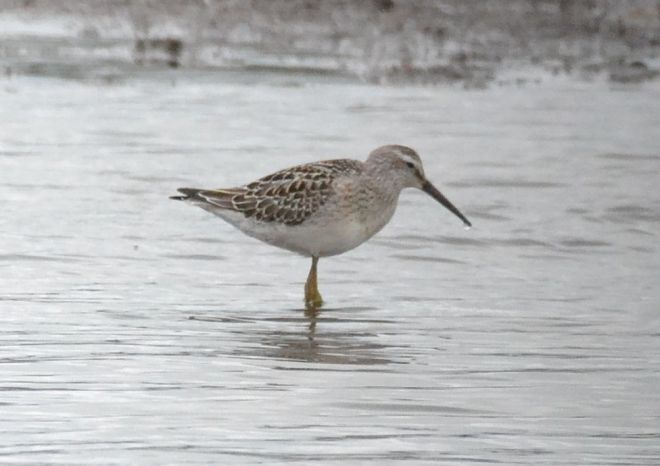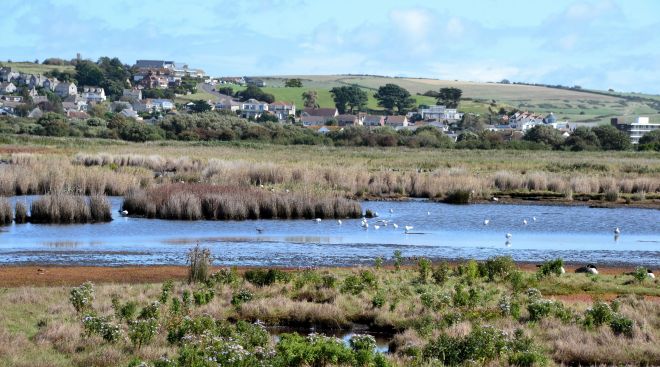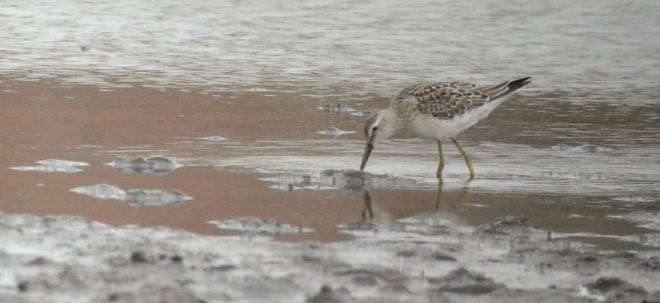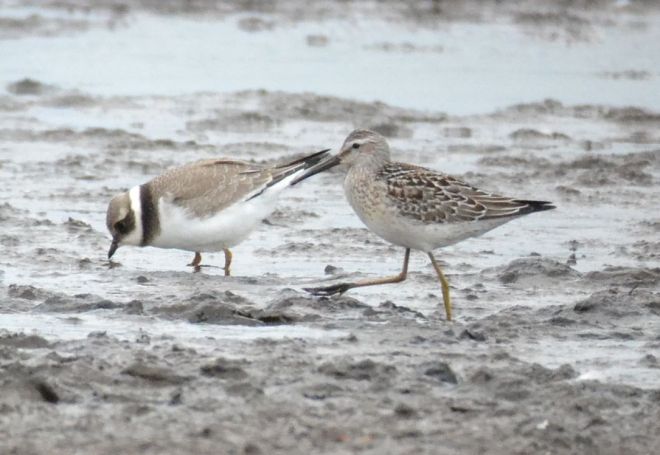The autumn bird passage season has now clicked into gear both nationally and locally with westerly gales bringing a variety of pelagic (ocean going) and Nearctic (north American) species to our shores. After the frustration of dipping four out of six selected national birds through the summer I will therefore be seeking renewed avian motivation in the coming weeks. The two groups offering the most potential for me personally are waders from the west and Siberian breeding passerines from the east.
Recent days have seen a fair smattering of Nearctic waders within my preferred range around the country. But these were all species I had logged previously: Pectoral, Baird’s and White-rumped Sandpipers; and Long-billed Dowitcher. Then on Tuesday morning (12th) one new record on RBA stood out: Stilt Sandpiper at one of my favourite south coast reserves, Lodmoor (SY687815) just outside of Weymouth. This was an important lifer and hence a must-see, and there was also a Least Sandpiper at the same site: a further Nearctic wader I have observed once previously (see here). But I was working the evening shift that day.

Stilt Sandpiper (juv) at Lodmoor
Strong winds on Monday had also brought in numbers of Grey Phalarope nationally, including one in north-Oxfordshire that I went to see. Walking away from there was Ewan, fresh from an epic outer Hebrides twitch to connect with the North American passerine of the autumn so far (see here). I told him of my plans for the morrow and he at once expressed an interest. With another storm set to batter Blighty through the intervening night it seemed hopeful the Dorset scarcities would not move on too soon, and so it transpired.
On the journey down my passenger checked the bird news at intervals. The overnight squalls had deposited many more Grey Phalarope at inland sites across England and Wales, including two more in Oxfordshire. Sabine’s Gull, Leach’s Petrel and other pelagics were being reported from all round the west and south coasts by those dedicated or dour enough to sit out in the conditions and log them. But there was nothing new of significant interest to myself.

The Stilt Sandpiper location at RSPB Lodmoor
We arrived on site late morning and the first birders met to the north of the reserve confirmed the Stilt Sandpiper was showing well at the location being cited on RBA. On our reaching that spot, at Lodmoor’s western edge the connect was immediate. The Stilt Sandpiper had a quite distinctive, generally pale appearance. Around one-third of the way between Dunlin and Redshank in size, today’s pristine juvenile displayed attractively scalloped upperparts and light breast streaking with a prominent supercilium (eye stripe) and down-curved bill. And then there were the long yellow legs, hence the species’ name. This was a very pleasing package all round. Juveniles are an extreme rarity in Britain, with most of the species records over the last 15 years thought to relate to the same couple of passage adults.
The bird was feeding in the middle distance amongst Redshank and Black-tailed Godwit. On our last successful twitch for a Marsh Sandpiper in Kent (see here) I had made the mistake of leaving my new Swarovski digiscoping collar in the car. This time I made sure to take it with me and though the results (below) are hardly sharp they illustrate this expensive piece of kit’s potential. I could have secured half-decent images on that other occasion had I not been so careless. On my right Ewan machine-gunned away using his 400mm Canon telephoto with 1.4 converter. To assess the outcome see here, not in any competitive way I stress but merely to compare technologies.
With the more important (for me) of the two visitors in the bag we moved on to observe the day’s second bird. The Least Sandpiper had relocated to the eastern end of Lodmoor and we came across it associating with two Ringed Plover. The juxtaposition emphasised just how tiny this true dwarf of the accidental small Sandpipers is, just 13cm in length. It would have been impossible to record this bird (below), also a juvenile feeding on rather distant mud without the disgiscoping collar. For a good picture of this bird see here.

Tiny Least Sandpiper (front left) with Ringed Plover
With both waders now seen well we could relax and enjoy our surroundings at this superb reserve. These were my third and fourth Nearctic waders at the site, where I had previously recorded Long- and Short-billed Dowitchers in November 2010 and September 2012 respectively. We next returned to the first spot to get more of the Stilt Sandpiper that had moved closer to the path. In the improved light the bird was moving around an area of subtle contrasts and I am quite pleased with these images. This is the first proper workout I have given the digiscoping collar and I must remember to take it with me in future.

Stilt Sandpiper (juv)

Stilt Sandpiper (right) with Ringed Plover (juv)

Stilt Sandpiper (left) with juvenile Knot
Below are more digiscoped pictures of some other interesting birds observed today. It had been a hugely enjoyable excursion that was only slightly spoiled when Ewan found on Twitter that another sneaky Oxon birder had got down to Lodmoor on Tuesday afternoon and blogged his account first. Really, some people have no shame! Adam’s experiences of the twin attraction (see here) seemed broadly parallel with our own.
So perhaps my recent birding fortunes have taken a turn for the better now. Things began at Oxford’s Farmoor Reservoir on Monday evening (11th) while I was in a hide with two other Oxon birders being grilled about some kind of year list it’s rumoured I keep in the county. Asked what are the two most obvious birds I have yet to see locally in 2017 I replied Ruff and Whimbrel. At that point three medium-sized waders flew past and I called: “What are those?” “They’re Ruff!” replied my companions in unison. This was a very minor occurrence but on such nuances perhaps can sequences of luck change.
When I got home the first of the three Grey Phalarope had been reported on Oxon Birding, and an exhausted Manx Shearwater had landed in someone’s garden north of Oxford. Things were picking up in the county and the following morning so it seemed nationally too. But first I went to Banbury’s Grimsbury Reservoir (SP460420) for the Phalarope, since if I was actually year listing I would need to see it. This is the third consecutive autumn in which we’ve had these ocean going waifs in Oxfordshire, and as usual the bird was very fearless probably having no prior experience of humans.
I am not used to seeing Phalaropes standing out of the water and so am particularly pleased with the first three pictures. They were taken through a wire mesh boundary fence, but at one point an angler laden with all his gear strode along the water’s edge right past the bird and it barely moved. That was incidentally most considerate of him as he could see what I was doing, but no doubt he pays to be there and birders do not.
Being out and about relaxing with the camera photographing insects has been very enjoyable through the summer, but the buzz that goes with having birds to see is something extra. Here’s hoping for more life list additions nationally in the autumn weeks ahead.

















